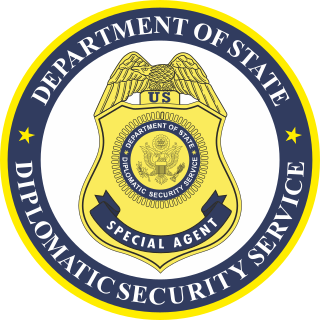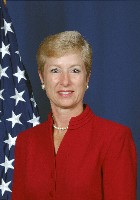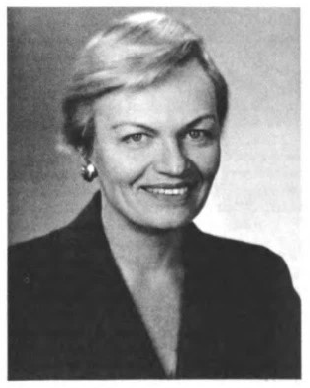
James Franklin Jeffrey is an American diplomat who served most recently as the United States Special Representative for Syria Engagement and the Special Envoy to the International military intervention against ISIL.

The United States Foreign Service is the primary personnel system used by the diplomatic service of the United States federal government, under the aegis of the United States Department of State. It consists of over 13,000 professionals carrying out the foreign policy of the United States and aiding U.S. citizens abroad. Its current director general is Marcia Bernicat.

The Diplomatic Security Service (DSS) is the principal law enforcement and security agency of the United States Department of State (DOS). As the operational division of DOS Bureau of Diplomatic Security, its primary mission is to provide security to protect diplomatic assets, personnel, and information, and combat transnational crimes connected to visa and passport fraud. DSS also conducts counterterrorism, counterintelligence, cybersecurity and criminal investigations domestically and abroad.
Diplomatic rank is a system of professional and social rank used in the world of diplomacy and international relations. A diplomat's rank determines many ceremonial details, such as the order of precedence at official processions, table seatings at state dinners, the person to whom diplomatic credentials should be presented, and the title by which the diplomat should be addressed.

The Foreign Service Institute (FSI) is the United States federal government's primary training institution for members of the U.S. foreign service community, preparing American diplomats as well as other professionals to advance U.S. foreign policy objectives overseas and in Washington. FSI provides more than 800 courses—including up to 70 foreign languages—to more than 225,000 enrollees a year from the U.S. Department of State and more than 50 other government agencies and the military service branches. FSI is based at the George P. Shultz National Foreign Affairs Training Center in Arlington, Virginia.

Samuel Vaughan Wilson, also known as General Sam, was a United States Army lieutenant general who completed his active military career in the fall of 1977, having divided his service almost equally between special operations and intelligence assignments.

A Foreign Service officer (FSO) is a commissioned member of the United States Foreign Service. Foreign Service officers formulate and implement the foreign policy of the United States. FSOs spend most of their careers overseas as members of U.S. embassies, consulates, and other diplomatic missions, though some receive assignments to serve at combatant commands, Congress, and educational institutions such as the various U.S. service academies.

Katherine Hubay Smith Peterson Canavan served as a United States diplomat and career foreign service officer for 35 years. She retired in November 2011 and has since supported a number of military courses and exercises as a Subject Matter Expert and role player, particularly when they involve an Ambassador, Country Team and the Interagency. She serves on the board of trustees for the Una Chapman Cox Foundation and is on the board of the American Academy of Diplomacy.

Albert Melrose Calland III was a vice admiral in the United States Navy who was the deputy director for Strategic Operational Planning at the National Counterterrorism Center and commander of Naval Special Warfare Command from 2002 to 2004. He also previously served as Deputy Director of the Central Intelligence Agency from July 2005 to July 2006 and commanded the Naval Special Warfare Development Group from 1997 to 1999.

Roger Dwayne Pierce is a United States diplomat and a career foreign service officer with the Department of State. As of 2008, he is serving as the foreign policy advisor with the U.S. Special Operations Command. His previous assignment was the post of Ambassador to the Republic of Cape Verde. He served in that post 2005–08.

Philippine Merchant Marine Academy is a maritime higher education institution operated by the Philippine government in San Narciso, Zambales. Students are called midshipmen but are often also referred to as cadets. Upon graduation, students are commissioned as ensigns in the Philippine Navy Reserve and have the option to join the merchant marine, the Philippine Navy, or the Philippine Coast Guard.

William Caldwell Harrop is an American diplomat. Harrop served for 39 years as a Foreign Service Officer, with postings as United States ambassador to Guinea, Kenya and the Seychelles, the Congo (Kinshasa), and Israel.

Keith W. Dayton is a retired lieutenant general in the United States Army who currently serves as the director of the George C. Marshall European Center for Security Studies in Garmisch-Partenkirchen, Germany. Dayton served as the U.S. Security Coordinator for Israel-Palestinian Authority in Tel Aviv, Israel from December 2005 to October 2010. He has also served as the Director of the Iraq Survey Group, as a senior member of the Joint Staff, and as U.S. Defense Attaché in the U.S. Embassy in Moscow, Russia.
Clientitis is the alleged tendency of resident in-country staff of an organization to regard the officials and people of the host country as "clients".
The Council of American Ambassadors (CAA) is an association of non-career United States ambassadors. A nonprofit and nonpartisan organization, the CAA comprises over 200 members whose ambassadorial service collectively extends over five decades and eleven U.S. presidents.
The Senior Foreign Service (SFS) comprises the top four ranks of the United States Foreign Service. These ranks were created by the Foreign Service Act of 1980 and Executive Order 12293 in order to provide the Foreign Service with senior grades equivalent to general and flag ranks in the military and naval establishments, respectively, and to grades in the Senior Executive Service. Like military ranks and other Foreign Service ranks, the Senior Foreign Service grade system assigns rank in person, not rank in position.

Jacques Paul Klein is a retired United States diplomat, who served as head of three United Nations peacekeeping missions: the United Nations Transitional Administration for Eastern Slavonia (UNTAES) from January 17, 1996, to August 1, 1997, the United Nations Mission in Bosnia and Herzegovina (UNMIBH) from July 16, 1999, to December 31, 2002, and the United Nations Mission in Liberia (UNMIL) from July 17, 2003, to July 20, 2005.

Natale Hans Bellocchi was an American industrial engineer from Little Falls, New York, a Korean War United States Army veteran, and United States diplomat. He served for years as a diplomatic courier and Foreign Service Officer, with numerous postings to nations in Asia, where he encouraged trade and commerce, and as ambassador to Botswana.

Everett Francis Drumright was an American diplomat who served in a variety of posts, including as U.S. Ambassador to the Republic of China (Taiwan).

Katherine W. Bracken was one of the few high-ranking female Foreign Service Officers (FSO) for the US Department of State in the late 1950s-1960s. She is notable for working at the Department and continuing to climb the ranks as a married woman during a time when the informal rule was for women to retire as soon as they were married.